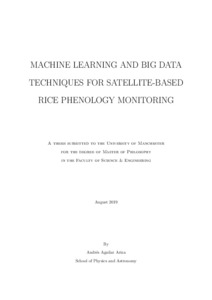Machine learning and big data techniques for satellite-based rice phenology
New sources of information are required to support rice production decisions. To cope with this challenge, studies have found practical applications on mapping rice using remote sensing techniques. This study attempts to implement a methodology aimed at monitoring rice phenology using optical satellite data. The relationship between rice phenology and reflectance metrics was explored at two levels: growth stages and biophysical modifications caused by diseases. Two optical moderate-resolution missions were combined to detect growth phases. Three machine-learning approaches (random forest, support vector machine, and gradient boosting trees) were trained with multitemporal NDVI data. Analytics from validation showed that the algorithms were able to estimate rice phases with performances above 0.94 in f-1 score. Tested models yielded an overall accuracy of 71.8%, 71.2%, 60.9% and 94.7% for vegetative, reproductive, ripening and harvested categories. A second exploration was carried out by combining Sentinel-2 data and ground-based information about rice disease incidence. K-means clustering was used to map rice biophysical changes across reproductive and ripening phases. The findings ascertained the remote sensing capabilities to create new information about rice for Colombia’s conditions.

